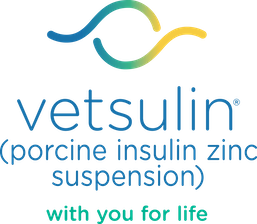

Treatment Monitoring
Learn More About Dosing & Administration
Changes in Insulin Requirements in Cats with Diabetes
Insulin requirements may change suddenly even after a long period of stability because of any of the following concurrent factors:
- Inflammation or infection (eg, cystitis)
- Weight loss or gain
- Additional medications
- Other illness (eg, renal failure, heart failure)
- Endocrine disease
- Neoplasia
In cats, dose adjustment should be managed in steps of 0.5-1 IU per injection twice daily, especially in the first 3 weeks of initial regulation. Following adjustment, wait to re-evaluate until the new dose has been given for at least 7-14 days, unless evidence of hypoglycemia appears.
The goal is to maintain blood glucose concentrations below the renal threshold for a substantial part of the day. This will alleviate most of the cat’s clinical signs, which is the main goal of therapy.
Monitoring and Adjusting Dose
Re-evaluate your feline patients 1 to 2 weeks after starting Vetsulin® (porcine insulin zinc suspension):
- Reweigh the cat. Modify overall dosage of Vetsulin if significant weight gains or losses occur.
- Consider delaying dosage adjustments to allow for impact of new diet.
- Ask for owner’s overall impression of the cat’s progress, especially in regard to polyuria and polydipsia.
- Sample blood glucose level to determine if regulation has been achieved, keeping in mind that cats often present with stress-induced hyperglycemia.
- Adjust dose in increments of 0.5-1 IU per injection twice daily, if needed, based on the glucose curve evaluation and clinical signs.
- Allow at least 7-14 days between dose adjustments unless hypoglycemia occurs.
- In stressed cats, measure serum fructosamine concentration prior to and 2 to 3 weeks after any dose changes.
- Once regulated on Vetsulin, cats should be rechecked every 2 to 4 months. Remember that cats, unlike dogs, can go into remission.
Help Your Practice Manage Diabetes Mellitus
Check out these tools and resources to help manage feline diabetes.

Blood Glucose Curve Generator
Create a blood glucose curve to monitor and evaluate diabetes treatments.

Client Discharge Form
Create a customized, printable form for clients about their new diagnosis.

Diabetes Resources
Access online tools and more to support staff and pet parents.
No items to show.
Learn More About Dosing & Administration
Important Safety Information:
Vetsulin® should not be used in dogs known to have a systemic allergy to pork or pork products. Vetsulin is contraindicated during periods of hypoglycemia. Keep out of reach of children. As with all insulin products, careful patient monitoring for hypoglycemia and hyperglycemia is essential to attain and maintain adequate glycemic control and prevent associated complications. Overdosage can result in profound hypoglycemia and death. The safety and effectiveness of Vetsulin in puppies, breeding, pregnant, and lactating dogs has not been evaluated. See package insert for full information regarding contraindications, warnings, and precautions.
References:
1. Martin GJ, Rand JS. Pharmacology of a 40 IU/ml porcine lente insulin preparation in diabetic cats: findings during the first week and after 5 or 9 weeks of therapy. J Feline Med Surg. 2001;3(1):23–30. 2. Vetsulin® (porcine insulin zinc suspension) [Freedom of Information Summary]. Millsboro, DE: Intervet Inc.; 2008. 3. Data on file, Merck Animal Health. 4. Graham PA, Nash AS, McKellar QA. Pharmacokinetics of porcine insulin zinc suspension in diabetic dogs. J Small Anim Pract. 1997;38(10):434–438. 5. Martin GJ, Rand JS. Pharmacokinetic and Pharmacodynamic Study of Caninsulin in Cats with Diabetes Mellitus. 2000: Internal Study Report. 6. Feldman EC, Nelson RW. Canine and Feline Endocrinology and Reproduction. 3rd ed. St. Louis, MO: Saunders; 2004:539–579. 7. Tennant B, ed. BSAVA Small Animal Formulary. 4th ed. Gloucestershire, UK: British Small Animal Veterinary Association; 2002. 8. Feldman EC, Nelson RW. Canine and Feline Endocrinology and Reproduction. 3rd ed. St. Louis, MO: Saunders; 2004:486–538. 9. Reusch C. Feline diabetes mellitus. In: Ettinger SJ, Feldman EC, eds. Textbook of Veterinary Internal Medicine. 7th ed. St. Louis, MO: Saunders; 2010:1796–1816. 10. Nelson RW. Canine diabetes mellitus. In: Ettinger SJ, Feldman EC, eds. Textbook of Veterinary Internal Medicine. 7th ed. St. Louis, MO: Saunders; 2010:1782–1796. 11. Burgaud S, Riant S, Piau N. Comparative laboratory evaluation of dose delivery using a veterinary insulin pen. In: Proceedings of the WSAVA/FECAVA/BSAVA congress; 12–15 April 2012; Birmingham, UK. Abstract 121. 12. Burgaud S, Guillot R, Harnois-Milon G. Clinical evaluation of a veterinary insulin pen in diabetic dogs. In: Proceedings of the WSAVA/ FECAVA/BSAVA congress; 12–15 April 2012; Birmingham, UK. Abstract 122. 13. Burgaud S, Guillot R, Harnois-Milon G. Clinical evaluation of a veterinary insulin pen in diabetic cats. In: Proceedings of the WSAVA/FECAVA/BSAVA congress; 12–15 April 2012; Birmingham, UK. Abstract 45. 14. Davison LJ, Walding B, Herrtage ME, Catchpole B. Anti-insulin antibodies in diabetic dogs before and after treatment with different insulin preparations. J Vet Intern Med. 2008;22:1317-1325. 15. Banfield State of Pet Health 2016 Report. p 12-13.
